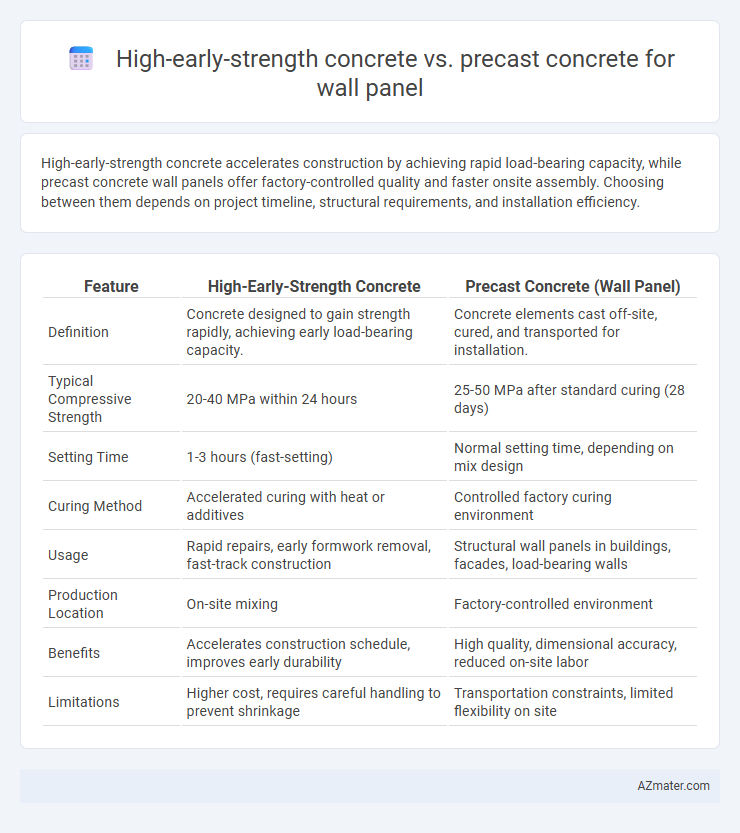High-early-strength concrete accelerates construction by achieving rapid load-bearing capacity, while precast concrete wall panels offer factory-controlled quality and faster onsite assembly. Choosing between them depends on project timeline, structural requirements, and installation efficiency.
Table of Comparison
| Feature | High-Early-Strength Concrete | Precast Concrete (Wall Panel) |
|---|---|---|
| Definition | Concrete designed to gain strength rapidly, achieving early load-bearing capacity. | Concrete elements cast off-site, cured, and transported for installation. |
| Typical Compressive Strength | 20-40 MPa within 24 hours | 25-50 MPa after standard curing (28 days) |
| Setting Time | 1-3 hours (fast-setting) | Normal setting time, depending on mix design |
| Curing Method | Accelerated curing with heat or additives | Controlled factory curing environment |
| Usage | Rapid repairs, early formwork removal, fast-track construction | Structural wall panels in buildings, facades, load-bearing walls |
| Production Location | On-site mixing | Factory-controlled environment |
| Benefits | Accelerates construction schedule, improves early durability | High quality, dimensional accuracy, reduced on-site labor |
| Limitations | Higher cost, requires careful handling to prevent shrinkage | Transportation constraints, limited flexibility on site |
Introduction to Wall Panel Construction Methods
High-early-strength concrete accelerates wall panel production by enabling rapid curing and early load-bearing capacity, essential for fast-track construction schedules. Precast concrete wall panels are manufactured off-site under controlled conditions, ensuring high quality, dimensional accuracy, and reduced on-site labor. Choosing between these methods depends on project timelines, structural requirements, and logistics efficiency for optimized wall panel construction.
Overview of High-Early-Strength Concrete
High-early-strength concrete achieves rapid strength gain within hours, allowing for faster form removal and reduced construction time in wall panel applications. Its enhanced chemical composition, often featuring higher cement content and accelerators, results in compressive strengths exceeding 6,000 psi in 24 hours. This concrete type is ideal for precast wall panels requiring quick turnaround without compromising structural integrity or durability.
Understanding Precast Concrete Wall Panels
Precast concrete wall panels are manufactured in controlled factory settings, ensuring high quality and uniformity, which contributes to enhanced durability and structural integrity. High-early-strength concrete is often utilized in precast panels to accelerate curing time, allowing for faster production cycles and quicker on-site installation. This combination optimizes the construction process by reducing project timelines while maintaining robust load-bearing capacity and surface finish quality.
Production Process: High-Early-Strength vs Precast Panels
High-early-strength concrete for wall panels accelerates curing time by utilizing rapid hydration to reach significant compressive strength within hours, enhancing early demolding and faster construction cycles. Precast panels are manufactured in controlled factory environments using standardized molds, allowing precise quality control and consistent dimensions but requiring transport logistics for installation. The high-early-strength approach optimizes on-site casting with reduced downtime, while precast panels emphasize off-site fabrication for scalable and repeatable production.
Installation Speed and On-Site Efficiency
High-early-strength concrete accelerates wall panel installation by reducing curing time to a few hours, enabling faster project progression and early load application. Precast concrete wall panels, manufactured off-site, offer consistent quality and rapid on-site assembly, minimizing weather-related delays and labor costs. Combining high-early-strength concrete with precast methods maximizes on-site efficiency by ensuring quick installation and early structural support.
Structural Performance and Durability Comparison
High-early-strength concrete achieves rapid strength gain, enabling faster formwork removal and construction schedules for wall panels, enhancing early load-bearing capacity. Precast concrete wall panels, manufactured under controlled conditions, generally offer superior dimensional accuracy and improved durability due to optimized curing and quality control processes. Structurally, high-early-strength concrete provides sufficient early performance but may exhibit higher shrinkage and cracking risk compared to precast panels, which deliver consistent long-term durability and resistance to environmental stressors.
Cost Analysis: Materials, Labor, and Lifecycle
High-early-strength concrete reduces project timelines by accelerating curing, lowering labor costs but often involves higher material expenses due to specialized admixtures. Precast concrete panels offer controlled factory conditions that optimize material usage and minimize onsite labor, resulting in predictable cost savings and less waste. Lifecycle costs favor precast concrete through enhanced durability and maintenance efficiency, while high-early-strength concrete supports faster initial project turnover, influencing overall budget allocation depending on project priorities.
Design Flexibility and Architectural Considerations
High-early-strength concrete offers significant design flexibility for wall panels by enabling quicker formwork removal and faster structural loading, which supports accelerated construction schedules and complex architectural shapes. Precast concrete wall panels provide precise dimensional control and uniform surface finishes, allowing for intricate detailing and consistent aesthetic quality in architectural design. While high-early-strength concrete accommodates on-site adjustments and custom configurations, precast panels excel in repetitive elements and modular construction with enhanced durability and thermal performance.
Sustainability and Environmental Impact
High-early-strength concrete enables faster construction cycles reducing site energy consumption, while precast concrete wall panels offer enhanced quality control and waste minimization through factory production. Precast panels typically have advantages in thermal efficiency and material reuse, contributing to lower lifecycle carbon footprints compared to cast-in-place solutions using standard mixes. Both methods support sustainable building practices, but integrating renewable materials and optimizing mix designs in high-early-strength concrete advances environmental performance in accelerated projects.
Choosing the Right Solution: Key Factors for Wall Panels
High-early-strength concrete offers rapid setting and early load-bearing capacity, making it ideal for projects with tight schedules and accelerated construction timelines. Precast concrete panels, manufactured in controlled environments, ensure superior quality, dimensional accuracy, and reduced on-site labor, enhancing overall project efficiency. Selecting between high-early-strength and precast concrete depends on factors such as project timeline, structural requirements, site conditions, and budget constraints for optimal wall panel performance.

Infographic: High-early-strength concrete vs Precast concrete for Wall panel
 azmater.com
azmater.com